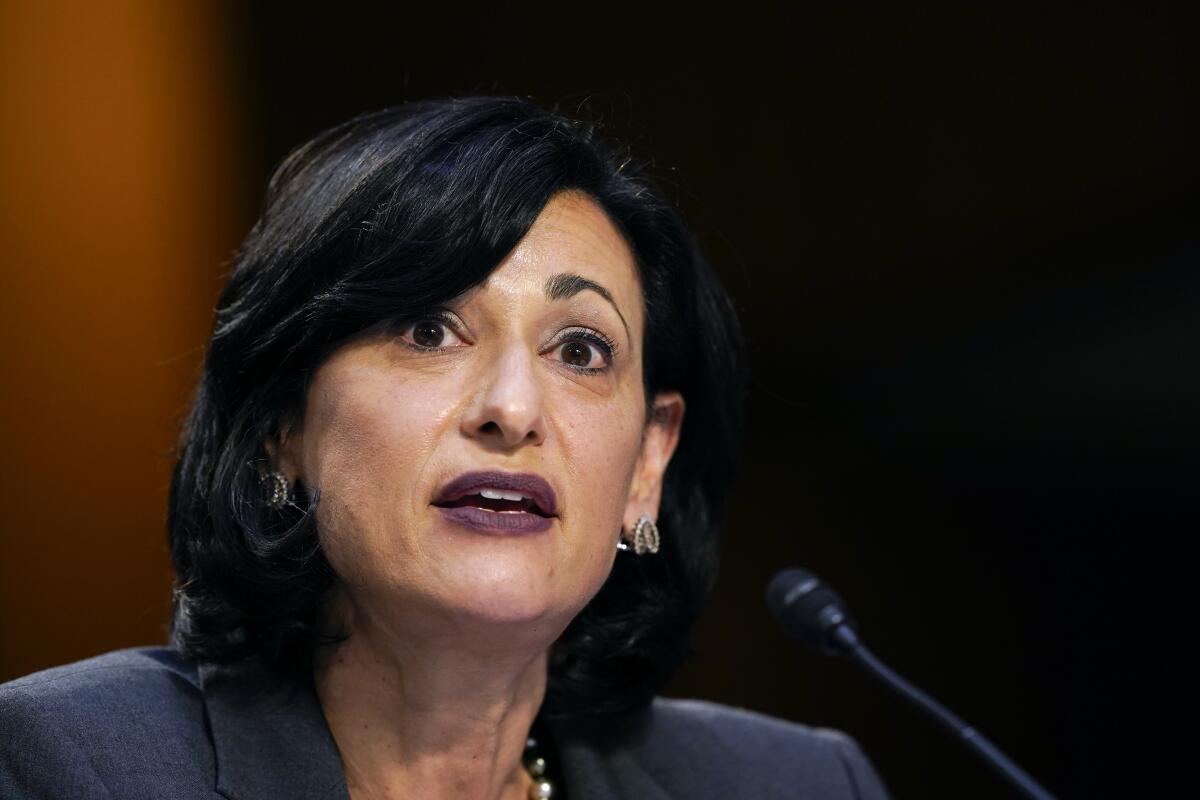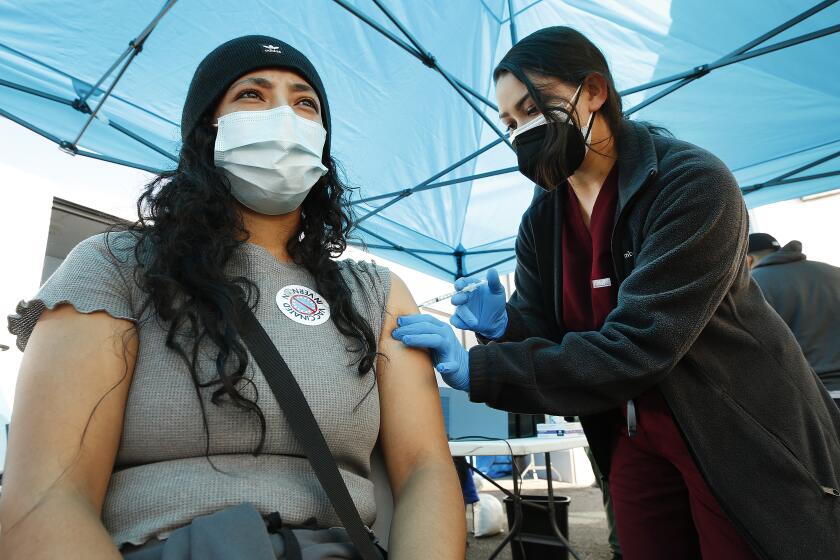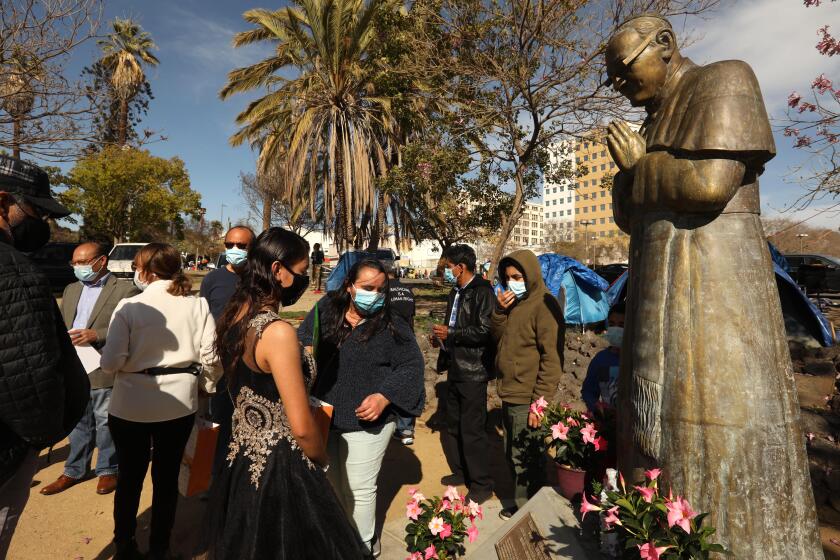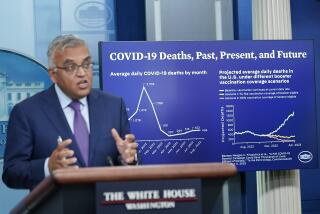Biden warns ‘we’re in a life-and-death race’ with COVID-19

- Share via
WASHINGTON — President Biden implored Americans to maintain precautions and expanded federal efforts to vaccinate the country as signs of a potential new surge in coronavirus cases spawned fears of a deadly fourth wave of infections and deaths.
The president announced Monday that in three weeks, by April 19, his administration will more than double the number of pharmacies where people can get shots. He also said 90% of American adults will have become eligible for the vaccine by that point, and the final 10% after May 1.
The faster timetable and expanded network of inoculation sites represent an effort to outrun the coronavirus as states loosen restrictions on public gatherings and people are eager to return to normal life. New infections, hospitalizations and deaths are all on the rise, fueled by looser behaviors and the virus’ contagious variants.
California is days away from dramatically expanding who is eligible to receive a COVID-19 vaccine. But will there be enough doses to go around?
“The war against COVID-19 is far from won,” Biden warned at the White House complex. “This is deadly serious.”
“We’re in a life-and-death race with a virus that is spreading quickly,” he added, and “we’re giving up hard-fought, hard-won gains.” Biden urged states to stop loosening restrictions on public gatherings and admonished people against “reckless behavior.”
He spoke soon after a White House briefing where Dr. Rochelle Walensky, director of the Centers for Disease Control and Prevention, told reporters that she felt a sense of “impending doom.”
Her voice cracked as she talked about treating dying patients and seeing the extra mobile morgue parked outside the hospital where she had previously worked in Massachusetts.
“We have so much to look forward to, so much promise and potential of where we are and so much reason for hope,” she said. “But right now, I’m scared.”

For weeks, public health officials have been warning the country to remain on guard, especially as caseloads stopped declining after winter’s spike of infections. Numbers are now rising again, and Walensky acknowledged that Americans are tired of the isolation caused by coronavirus restrictions more than one year after the disease was declared a pandemic. But she pleaded for people to continue wearing masks and to keep their distance from one another.
“I’m asking you to just hold on a little while longer, to get vaccinated when you can, so that all of those people that we all love will still be there when this pandemic ends,” she said.
Walensky said she would be meeting with governors on Tuesday to urge them to keep restrictions in place, but the federal government has limited tools to ensure compliance, especially in large, Republican-led states where limitations are politically unpopular. Texas has already ended its statewide mask mandate and Florida welcomed an influx of vacationers for spring break.
Some states in the Northeast and Midwest face bigger problems. New Jersey, New York and Michigan have some of the fastest-rising caseloads.
Even as vaccinations increase and COVID-19 cases low in California, officials urge caution during the spring holidays, including Easter and Passover.
“If we open up completely now, that is premature given the level of infection,” said Dr. Anthony Fauci, the federal government’s top expert on infectious diseases. He used Monday’s briefing to display X-rays of lungs to remind people of the damage that COVID-19 could do.
Hospital admissions have increased to an average of 4,816 per day over the last week, up from 4,621 the week before that. COVID-19 deaths are also on the rise, with an average of 968 people dying each day over the last week, up from 944 during the previous seven days. The country is nearing an average of 60,000 new cases per day.
“The baseline we’re starting from is a very bad baseline,” said Dr. Eric Toner, a senior scholar at the Johns Hopkins Center for Health Security. “Even a relatively mild surge from this level is concerning.”
The more contagious coronavirus variant that originated in the United Kingdom, known as B.1.1.7, is worsening the situation.
“There’s no other country that I’m aware of that’s seeing major B.1.1.7 activity that’s opening up everything rather than locking it down,” said Michael Osterholm, director of the Center for Infectious Disease Research and Policy at the University of Minnesota. “You could not create a more perfect storm.”
The rising cases are threatening Biden’s effort to contain the pandemic, the core challenge of his presidency. To date, he’s been able to tout progress from expanded vaccination efforts; having hit his 100-day target in 58 days, he just doubled his goal for inoculations to 200 million shots administered by April 30.
Osterholm said it will be some time before restrictions should be lifted, despite the progress on vaccinations.
“We still have a lot of people who are vulnerable to this virus,” he said.
Although the United States has made considerable progress toward vaccinating the adult population, the results are uneven. A new analysis of the latest CDC data by the Kaiser Family Foundation found that on average, the 2,247 counties that have reported data have vaccinated an average of 15.8% of their populations and 46.7% of their senior citizens.
Within that average, however, county results ranged widely. The counties with the highest vaccination rates, mostly in Alaska, had given shots to more than 40% of their total populations. At the other end of the scale, some counties remain in single digits.
Overall, counties with high proportions of poor people, Black and Latino residents and people with medical conditions that put them at risk tend to have somewhat lower vaccination rates. Counties with larger proportions of elderly residents and with less poverty tend to have higher vaccination rates.
Within California, the highest average vaccination rate was in wealthy Marin County, 25%, according to the data, and the two lowest, Kings and Merced counties, are in the Central Valley.
Times staff writer David Lauter contributed to this report.
More to Read
Get the L.A. Times Politics newsletter
Deeply reported insights into legislation, politics and policy from Sacramento, Washington and beyond. In your inbox twice per week.
You may occasionally receive promotional content from the Los Angeles Times.













